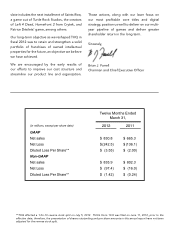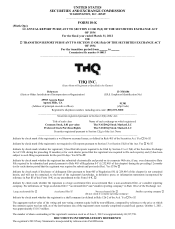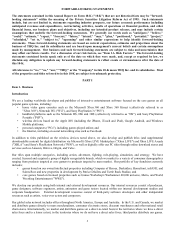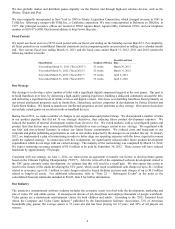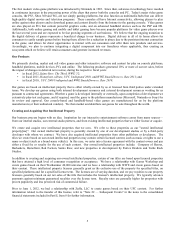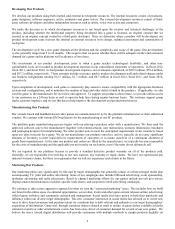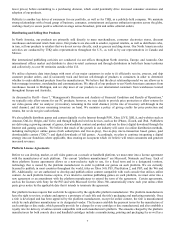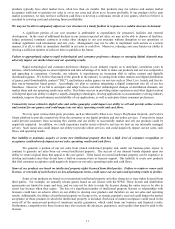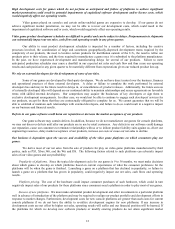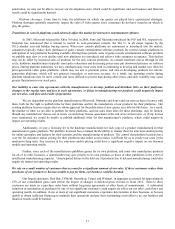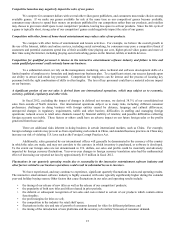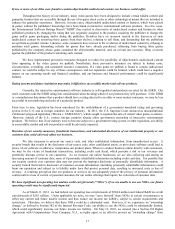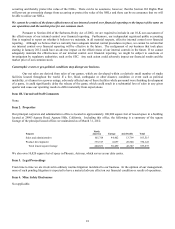THQ 2012 Annual Report Download - page 16
Download and view the complete annual report
Please find page 16 of the 2012 THQ annual report below. You can navigate through the pages in the report by either clicking on the pages listed below, or by using the keyword search tool below to find specific information within the annual report.8
royalty for the use of the platform manufacturer's name, proprietary information and technology, and are subject to adjustment
by the platform manufacturers at their discretion.
The platform license agreements also require us to indemnify the platform manufacturers with respect to all loss, liability and
expense resulting from any claim against the platform manufacturer involving the development, marketing, sale, or use of our
games, including any claims for copyright or trademark infringement brought against the platform manufacturer. Each platform
license may be terminated by the platform manufacturer if a breach or default by us is not cured after we receive written notice
from the platform manufacturer, or if we become insolvent. Upon termination of a platform license for any reason other than
our breach or default, we have a limited period of time to sell any existing product inventory remaining as of the date of
termination. The length of this sell-off period varies between 90 and 180 days, depending upon the platform agreement. We
must destroy any such inventory remaining after the end of the sell-off period. Upon termination as a result of our breach or
default, we must destroy any remaining inventory within a minimum number of days as specified by the platform manufacturer.
Seasonality; Deferral of Revenue
The interactive entertainment software industry is highly seasonal, with sales typically significantly higher during the third
quarter of our fiscal year, due primarily to the increased demand for interactive games during the year-end holiday buying
season. Additionally, our net sales are impacted by the deferral and/or recognition of revenue from the sale of titles for which
the online service is more-than-inconsequential to the overall functionality of the game and for which we have a continuing
involvement. Such deferrals are recognized ratably over the estimated service period, generally six months, beginning the
month after initial sale. As a result, the quarter in which we generate the highest shipping volume may be different than the
quarter in which we recognize the highest amount of net sales. Our results can also vary based on a number of factors,
including title release dates, consumer demand for our products, market conditions and shipment schedules.
Major Customers
Our largest customers worldwide include Best Buy, COKeM, GameStop, Target and Wal-Mart. We also sell our products to
other national and regional retailers, discount store chains, specialty retailers and distributors. Excluding the impact of changes
in deferred net revenue, GameStop and Wal-Mart each accounted for more than 10% of our gross sales in fiscal 2012. In fiscal
2011 we entered into two new "supplier" agreements with Wal-Mart, which includes both Wal-Mart and Sam's stores (one for
our console products and one for our PC products). The supplier agreements address certain standard terms and conditions,
such as payment terms, between us and Wal-Mart; however, the agreements do not contain any commitment for Wal-Mart to
purchase, or for us to sell, any minimum level of products. We do not have any agreements with GameStop. With respect to
both Wal-Mart and GameStop, as well as our other customers, the customer submits a purchase order for each purchase
request, and that purchase order contains basic pricing and delivery terms for such purchase. None of the purchase orders
individually, with any customer, accounted for more than 10% of the Company's consolidated net sales for fiscal 2012. A
substantial reduction in purchases, termination of purchases, or business failure by any of our largest customers could have a
material adverse effect on us.
Competition
As a publisher of interactive entertainment software, we consider ourselves to be part of the entertainment industry. At the most
fundamental level, our products compete with other forms of entertainment, such as motion pictures, television, music, Internet
and online services for the leisure time and discretionary spending of consumers. Our primary competition for sales of video
games comes from Microsoft, Nintendo and Sony, each of which is a large developer and publisher of software for its own
platforms, as well as other publishers and developers of interactive entertainment software, such as Activision/Blizzard,
Electronic Arts, Sega, Take-Two Interactive Software, and Ubisoft. Additionally, certain large intellectual property owners,
such as Disney, Viacom, and Warner Bros. have established video game units to develop and publish games based upon certain
of the properties they own. In recent years, our competition has expanded to include online publishers of interactive
entertainment, such as Zynga.
In addition to competing for video game sales, we compete for licenses and brand-name recognition, access to distribution
channels, and effectiveness of marketing and price. We also face competition from our competitors for the services of talented
video game producers, artists, engineers and other employees.
Employees
As of March 31, 2012, we employed approximately 1,088 people, of whom over 402 were outside the United States. We
believe that our ability to attract and retain qualified employees is a critical factor in the successful development and
exploitation of our products and that our future success will depend, in large measure, on our ability to continue to attract and


